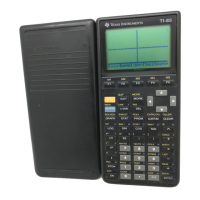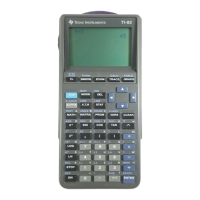A design goal for the program was never to attempt to plot beyond the maximum x-value specified by
xh. This goal is desirable because the function might not even be defined beyond xh, or it might be
increasing so rapidly that the resulting y-axis scaling would degrade the plot resolution. This is
prevented by using the floor() function to calculate the number of points plotted. The side effect of this
approach is that the function might not be plotted all the way to xh if the resolution is not set to 1. This
is not catastrophic, in fact, the built-in function and data plotters do the same thing.
The time savings with plotintg() can be significant, as shown below. The numbers in parenthesis show
the plot time in seconds/point. For the plotintg() results, execution times are shown both for passing the
integrand as a string (STR) and as an expression (EXP).
STR: 1:58 (0.49)
EXP: 1:36 (0.40)
0:73 (0.31)STR: 1:42 (0.64)
EXP: 1:21 (0.51)
0:47 (0.30)x
x0 = xl = 0
xh = 1
res = 1
STR: 1:42 (0.43)
EXP: 1:32 (0.38)
0:43 (0.18)STR: 1:27 (0.55)
EXP: 1:16 (0.48)
0:42 (0.26)1
x0 = xl = 0
xh = 1
res = 1
STR: 5:38 (1.41)
EXP: 3:01 (0.76)
Not finished in
30 minutes,
'Questionable
accuracy' shown
STR: 5:14 (1.97)
EXP: 3:58 (1.50)
Not finished in
35 minutes,
"Questionable
accuracy' shown
ln(x)/sin(x)
x0 = xl = 0.1
xh = 3.1
res = 1
STR: 4:21 (1.09)
EXP: 2:34 (0.64)
15:07 (3.78)STR: 3:59 (1.50)
EXP: 3:27 (1.30)
14:25 (5.41)sin(x)/x
x0 = xl = 0
xh = 15
res = 1
TI92+ HW2
plotintg()
TI92+ HW2
built-in plotter
TI89 HW1
plotintg()
TI89 HW1
built-in plotter
Integrand
function
For the first two functions in the table, plotintg() is much faster than the built-in plotter. However, for the
last two functions, the built-in plotter is faster. Perhaps if the 89/92+ AMS can find a symbolic solution,
it uses that solution to evaluate the integral, which would be much faster. Again, always first try to
evaluate the integral symbolically - plotting the symbolic solution will always be faster than evaluating
the integral.
plotintg() does no error checking. Results may be unpredictable if invalid arguments are used.
The program shown below, plotinui(), provides a user interface to plotintg(). It simply prompts for the
arguments, does some simple validation of the user input, and calls plotintg().
plotinui()
Prgm
©Interface for plotintg() integral plotter
©Calls plotintg() in same folder
©12dec00/dburkett@infinet.com
local umode,et
©umode saves the user's modes, to be restored on exit
©et is the error dialog box title
©Initialize
©Set the error dialog box title
"ERROR"→et
©Save the user's modes
4 - 12

